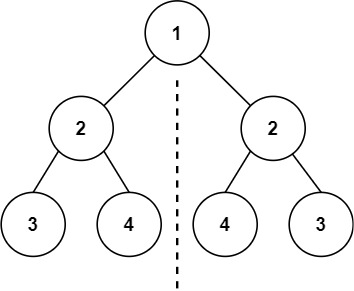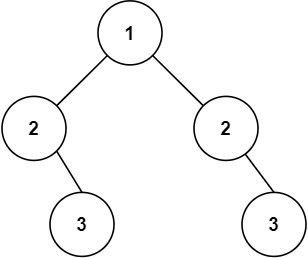二叉树反转对称
226. Invert Binary Tree
Given the root of a binary tree, invert the tree, and return its root.
Example 1:

Input: root = [4,2,7,1,3,6,9]
Output: [4,7,2,9,6,3,1]
Example 2:

Input: root = [2,1,3]
Output: [2,3,1]
Example 3:
Input: root = []
Output: []
Constraints:
- The number of nodes in the tree is in the range
[0, 100]. -100 <= Node.val <= 100
思路
确定遍历顺序,推荐使用前序遍历和后序遍历。
C++解法
/**
* Definition for a binary tree node.
* struct TreeNode {
* int val;
* TreeNode *left;
* TreeNode *right;
* TreeNode() : val(0), left(nullptr), right(nullptr) {}
* TreeNode(int x) : val(x), left(nullptr), right(nullptr) {}
* TreeNode(int x, TreeNode *left, TreeNode *right) : val(x), left(left), right(right) {}
* };
*/
class Solution {
public:
TreeNode* invertTree(TreeNode* root) {
if(root == nullptr){
return root;
}
invertTree(root->left);
invertTree(root->right);
swap(root->left, root->right);
return root;
}
};
Java解法
/**
* Definition for a binary tree node.
* public class TreeNode {
* int val;
* TreeNode left;
* TreeNode right;
* TreeNode() {}
* TreeNode(int val) { this.val = val; }
* TreeNode(int val, TreeNode left, TreeNode right) {
* this.val = val;
* this.left = left;
* this.right = right;
* }
* }
*/
class Solution {
public TreeNode invertTree(TreeNode root) {
if(root == null){
return null;
}
if(root.left == null && root.right == null){
return root;
}
TreeNode temp = root.left;
root.left = root.right;
root.right = temp;
root.left = invertTree(root.left);
root.right = invertTree(root.right);
return root;
}
}
Python3解法
# Definition for a binary tree node.
# class TreeNode:
# def __init__(self, val=0, left=None, right=None):
# self.val = val
# self.left = left
# self.right = right
class Solution:
def invertTree(self, root: Optional[TreeNode]) -> Optional[TreeNode]:
if not root:
return
temp = root.left
root.left = root.right
root.right = temp
self.invertTree(root.left)
self.invertTree(root.right)
return root
Go解法
101. Symmetric Tree
Given the root of a binary tree, check whether it is a mirror of itself (i.e., symmetric around its center).
Example 1:

Input: root = [1,2,2,3,4,4,3]
Output: true
Example 2:

Input: root = [1,2,2,null,3,null,3]
Output: false
Constraints:
- The number of nodes in the tree is in the range
[1, 1000]. -100 <= Node.val <= 100
Follow up: Could you solve it both recursively and iteratively?
思路
只能使用后序遍历
C++解法
/**
* Definition for a binary tree node.
* struct TreeNode {
* int val;
* TreeNode *left;
* TreeNode *right;
* TreeNode() : val(0), left(nullptr), right(nullptr) {}
* TreeNode(int x) : val(x), left(nullptr), right(nullptr) {}
* TreeNode(int x, TreeNode *left, TreeNode *right) : val(x), left(left), right(right) {}
* };
*/
class Solution {
public:
bool compare(TreeNode* left, TreeNode* right){
if(left == NULL && right == NULL){
return true;
}else if(left == NULL || right == NULL){
return false;
}else if(left->val == right->val){
return compare(left->right, right->left) && compare(left->left, right->right);
}else{
return false;
}
}
bool isSymmetric(TreeNode* root) {
if(root == NULL){
return true;
}
return compare(root->left, root->right);
}
};
Java解法
/**
* Definition for a binary tree node.
* public class TreeNode {
* int val;
* TreeNode left;
* TreeNode right;
* TreeNode() {}
* TreeNode(int val) { this.val = val; }
* TreeNode(int val, TreeNode left, TreeNode right) {
* this.val = val;
* this.left = left;
* this.right = right;
* }
* }
*/
class Solution {
public boolean isSymmetric(TreeNode root) {
if(root == null) return true;
return isMirror(root.left, root.right);
}
public boolean isMirror(TreeNode left, TreeNode right){
if(left == null && right == null) return true;
else if(left == null || right == null) return false;
else if(left.val != right.val) return false;
return isMirror(left.left, right.right) && isMirror(left.right, right.left);
}
}
Python3解法
# Definition for a binary tree node.
# class TreeNode(object):
# def __init__(self, val=0, left=None, right=None):
# self.val = val
# self.left = left
# self.right = right
class Solution(object):
def isSymmetric(self, root):
"""
:type root: TreeNode
:rtype: bool
"""
if not root:
return True
return self.isMirror(root.left, root.right)
def isMirror(self, left, right):
if not left and not right:
return True
if not left or not right:
return False
return left.val == right.val and self.isMirror(left.left, right.right) and self.isMirror(left.right, right.left)